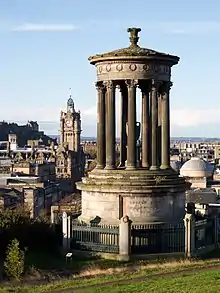Dugald Stewart Monument
The Dugald Stewart Monument is a memorial to the Scottish philosopher Dugald Stewart (1753–1828). It is situated on Calton Hill overlooking the city of Edinburgh and was designed by Scottish architect William Henry Playfair. It was completed in September 1831.[1][2]
 | |
| Coordinates | 55°57′19″N 3°10′56″W |
|---|---|
| Location | Calton Hill, Edinburgh, Scotland |
| Designer | William Henry Playfair |
| Material | stone |
| Completion date | August 1831 |
| Dedicated to | Dugald Stewart |
Background
Playfair's design is based on the Choragic Monument of Lysicrates in Athens, Greece, and is a circular temple of nine fluted Corinthian columns around an elevated urn, on a circular podium. This example of the architecture of ancient Greece had been brought to wider attention by James "Athenian" Stuart and Nicholas Revett's illustrated survey, The Antiquities of Athens, published in 1762. The monument is a category A listed building as of 19 April 1966. The choragic form was also used for the nearby contemporaneous Robert Burns Monument, designed by Thomas Hamilton.[1][2]
Dugald Stewart was a professor at the University of Edinburgh, holding the chair of moral philosophy from 1786 until he died in 1828. The Royal Society of Edinburgh commissioned the monument and selected its site in 1830.[3]
Playfair also designed the nearby National Monument of Scotland (with Charles Robert Cockerell) and was also responsible for the thoroughfare that encircles Calton Hill on three sides, comprising Royal Terrace, Carlton Terrace and Regent Terrace
References
- Historic Environment Scotland. "Calton Hill, off Regent Road, Dugald Stewart's Monument (Category A Listed Building) (LB27835)". Retrieved 18 March 2019.
- "Edinburgh, Calton Hill, Dugald Stewart's Monument". CANMORE. Retrieved 27 December 2017.
- "Edinburgh, Calton Hill, Dugald Stewart's Monument". www.britishlistedbuildings.co.uk. Retrieved 27 December 2017.
